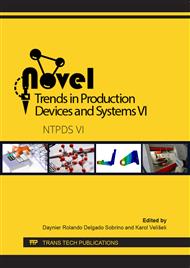[1]
Lange K., Umformtechnik – Handbuch fur Industrie und Wissenschaft, second ed., Springer/Verlag, Berlin, (2002).
Google Scholar
[2]
Mahrenholtz O., Bontcheva N., Iankov R., Influence of surface roughness on friction during metal forming processes. J. of Mat. Proc. Technol. 159 (2005) 9-16.
DOI: 10.1016/j.jmatprotec.2003.10.009
Google Scholar
[3]
Bilík J., Titel V., Dobisova M., Suba R., Formability of CP-W 800 steel sheets. Research Papers FMSaT in Trnava, Slovak University of Technology in Bratislava 27 (2009) 15-20.
Google Scholar
[4]
Mihaliková M., Lišková A., Dynamic characteristics of automotive steel sheets, Metallurgy 55 (2016) 753-756.
Google Scholar
[5]
Hrivnak A., Evin, E., Formability of steel sheets, first ed., Elfa, Košice, (2004).
Google Scholar
[6]
Sniekers R. J. J. M., Smits H. A. A., Experimental set-up and data processing of the radial strip-drawing friction test, J. Mat. Proc. Technol. 66 (1997) 216-223.
DOI: 10.1016/s0924-0136(96)02526-5
Google Scholar
[7]
Zhenyu H, Vollertsen F., A new friction test method, J. for Technol. of Plasticity 29 (2004) 1-9.
Google Scholar
[8]
Antoszewski B., Evin E., Audy J., A study of the effect of type (Cu+Ti) and (Mo+Ti) electro-spark coatings on friction in pin-on-disc testing, J. of Tribology 130 (2008) 0213031 -0213036.
DOI: 10.1115/1.2842296
Google Scholar
[9]
Vollertsen F., Zhenyu H., Determin. of size dependent friction funct. in sheet metal forming with respect to the distrib. of contact pressure, Prod. Eng. - Res. and Dev. 2 (2008) 345-350.
DOI: 10.1007/s11740-008-0130-4
Google Scholar
[10]
Evin E., Nemeth S., Vyrostek M., Evaluation of Friction Coefficient of Stamping, Acta Mechanica Slovaca 18 (2014) 20-27.
DOI: 10.21496/ams.2014.027
Google Scholar
[11]
Audy J., Evin E. 2008. Exploring efficiency of tool coating via deep drawing of cylindrical cups, MM Science Journal 6 (2008) 20-23.
DOI: 10.17973/mmsj.2008_06_20080601
Google Scholar
[12]
Evin E., Pinko P., Kmec J., Numerical simulation of deep-drawing process and coefficient of friction, Manufacturing Engineering 5 (2006) 18-22.
Google Scholar
[13]
Vyboch J., Evin E., Kmec J., Tribological Aspects of Numerical Simulation of Deep-Drawing Process, Manufacturing Engineering 3 (2011) 38-41.
Google Scholar
[14]
Pradeep Menezes L., Kumar K., Kishore R., Satish Kailas V., Influence of friction during forming processes study using a numerical simulation technique, The Int. J. of Adv. Manuf. Technol. 40 (2009) 1067-1076.
DOI: 10.1007/s00170-008-1425-5
Google Scholar
[15]
Schrek A., Švec P., Brusilová A., Gábrišová Z., Simulation process deep drawing of tailor welded blanks DP600 and BH220 materials in tool with elastic blankholder, Strojnicky Casopis, 68, (2018) 95-102.
DOI: 10.2478/scjme-2018-0010
Google Scholar
[16]
Trzepieciński, T., Analysis of contact of a rigid sphere against a deformable flat, Acta Metallurgica Slovaca 21 (2015) 285-292.
DOI: 10.12776/ams.v21i4.632
Google Scholar
[17]
Neto D. M., Oliveira M. C., Alves J. L., Menezes L. F., Influence of the plastic anisotropy modelling in the reverse deep drawing process simulation, Materials and Design 60 (2014), 368-379.
DOI: 10.1016/j.matdes.2014.04.008
Google Scholar
[18]
Kim S., Lee J., Barlat F., Lee M-G, Formability prediction of advanced high strength steels using constitutive models characterized by uniaxial and biaxial experiments, J. Mater. Process. Technol. 213 (2013) 1929–(1942).
DOI: 10.1016/j.jmatprotec.2013.05.015
Google Scholar


